by Lisa Cooke | Dec 21, 2016 | 01 What's New, DNA, MyHeritage |
MyHeritage DNA is new on the scene of genetic genealogy. With the recent launch of their DNA Matching, I decided to give it a test drive for you. I have now uploaded my test results from another company. Follow along as I share what I like about the MyHeritage DNA site…maybe it is just what you’ve been looking for!
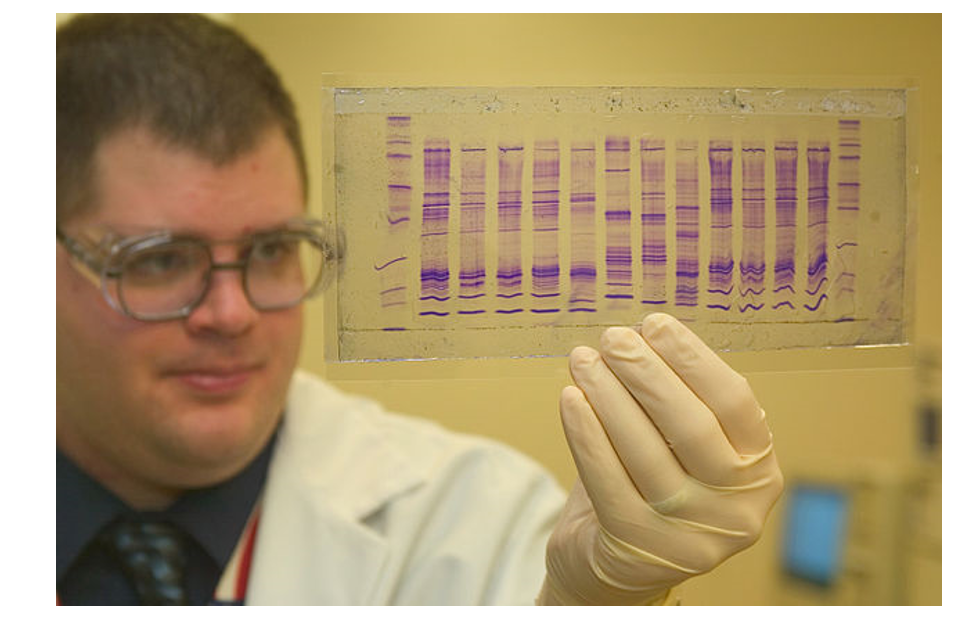
By James Tourtellotte, photo editor of CBP Today[1] [Public domain], via Wikimedia Commons.
In September, MyHeritage began to provide matching results for individuals who had uploaded their test results from another company to their site. As of today, uploading your DNA test results to MyHeritage DNA is still free, so if you have been thinking about it, you may want to take advantage sooner rather than later. As expected, the matches are only as good as the depth of the database, and it is early in the game. Their DNA database is small, but even now we can get an idea of what to expect from MyHeritage as they take their first steps into genetic genealogy.
One of the most exciting elements of their November 7, 2016 announcement is their development of a Founder Population project where they have hand-picked individuals to represent their reference population for calculating ethnicity. They plan to launch with 25 population groups, but will likely increase to 100 in a fairly short amount of time. This is a far more advanced ethnicity report than is currently offered anywhere else.
Transferring Your DNA Results to MyHeritage DNA
After you have figured out how to download your raw data from your testing company (see my instructions here: http://www.yourdnaguide.com/transferring), and add it to MyHeritage (you have to add a family tree to MyHeritage to do this), you will need to wait the requisite time to process. Then, you will receive an email notice that you have new DNA matches:
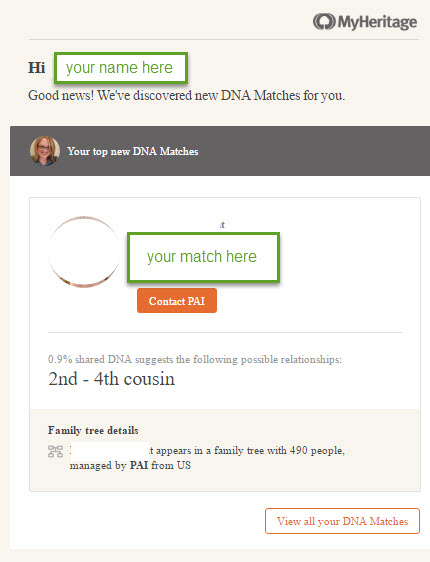
Email notice from MyHeritage regarding DNA matches.
You can access DNA matches when you log on to the site: under Discoveries, click DNA Matches (as shown below).

My Favorite Features of MyHeritage DNA
As for my favorite features, I like how they list all the possible relationships that make sense between you and your match, taking into account multiple factors like your age, gender, and your genetics instead of a simple, generic range like 2nd-4th buy chlamydia medication uk cousins. The accompanying chart, which visually shows you all possible relationships, is also very helpful. You can access the chart by clicking on the little question mark icon next to the relationship suggestions.
I like that these suggestions remind us that our genetic relationships have different genealogical interpretations. Meaning that genetically, a 2nd-cousin-once-removed, a first-cousin-twice-removed, and a second-cousin, all fall within a similar genetic range and it is impossible to determine your exact relationship based on the genetics alone.
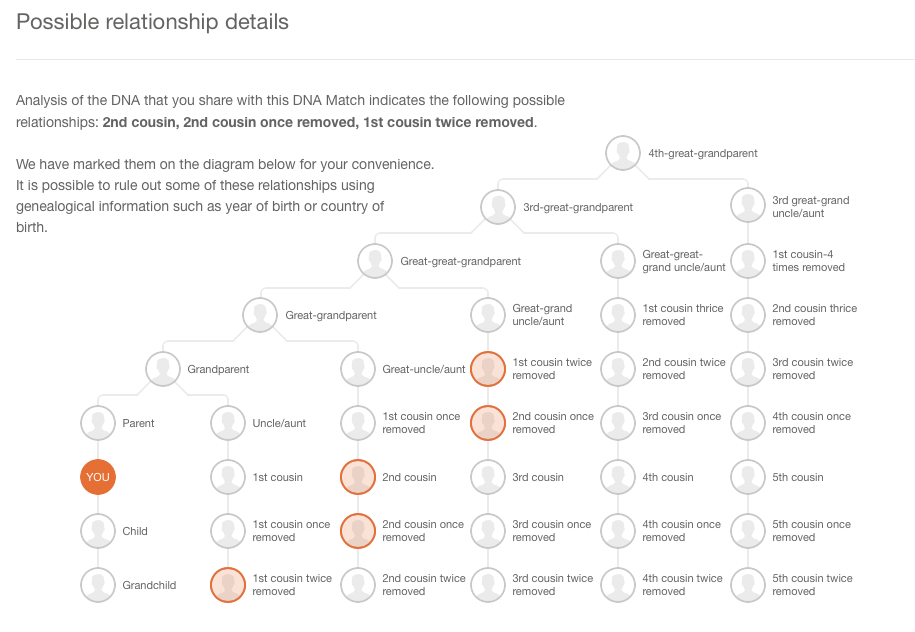
I also like how MyHeritage offers all three genetic descriptors of your relationship:
- total amount of shared DNA
- how many segments are shared
- the size of the longest piece of shared DNA.
While this is more of an intermediate to advanced piece to your results, it can be important as your relationship analysis becomes more involved.
Addressing a Concern of Genetic Genealogists
MyHeritage makes a unique claim in their press release about their matching feature addressing a main concern genetic genealogists have: the lack of pedigree information provided by their matches. MyHeritage claims that 95% of their DNA samples have pedigrees attached. That is remarkable! However, from my own quick calculation of my matches, the number with pedigrees is more like 60%.
They also indicated that they will soon be doing a bit of pedigree-analysis for you by providing a list of shared surnames and locations between you and your match. This will be based on the pedigrees you have both submitted and will certainly be a welcome addition.
 According to their November 9th Q and A, MyHeritage hasn’t decided yet if the ethnicity features will be available to those who only transfer, and they hint at many more features they have in the works that may only be offered to those who purchase their test.
According to their November 9th Q and A, MyHeritage hasn’t decided yet if the ethnicity features will be available to those who only transfer, and they hint at many more features they have in the works that may only be offered to those who purchase their test.
In short, the MyHeritage DNA site is currently functioning much like the top three genetic genealogy sites (Ancestry, Family Tree DNA, and 23andMe) and like the free tool Gedmatch: it offers a meeting place for those who have been tested at one company to meet those who have tested at another.
More on DNA Testing and Genealogy
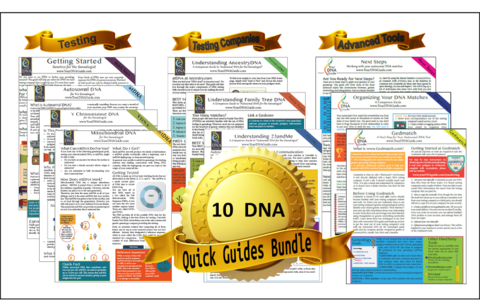 DNA testing is an incredible tool for genealogists. With several different types of tests and testing companies, hundreds of matches, and lots of technical jargon, it can be challenging to make sense of it all. My DNA Quick Guides to help you pick the right test, understand your results, and take the next steps with your matches. These guides can be purchased in printed format or digital downloads.
DNA testing is an incredible tool for genealogists. With several different types of tests and testing companies, hundreds of matches, and lots of technical jargon, it can be challenging to make sense of it all. My DNA Quick Guides to help you pick the right test, understand your results, and take the next steps with your matches. These guides can be purchased in printed format or digital downloads.
by Lisa Cooke | Jul 19, 2016 | 01 What's New, Adoption, Book Club, Genealogy Gems Podcast, Listeners & Readers
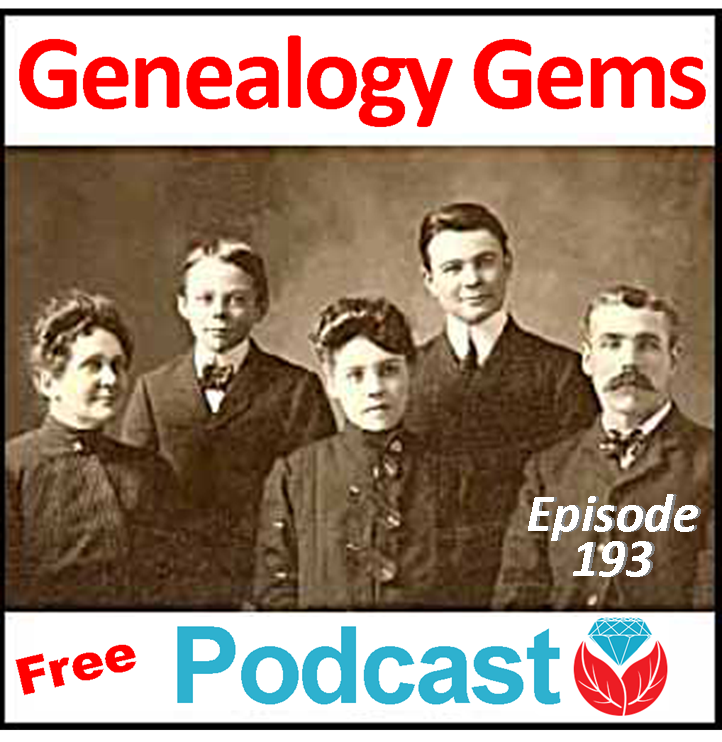 The Genealogy Gems Podcast episode 193 is ready for listening! It’s packed with genealogy news you can use; inspiring tips from listeners and experts and the NEW Genealogy Gems Book Club pick.
The Genealogy Gems Podcast episode 193 is ready for listening! It’s packed with genealogy news you can use; inspiring tips from listeners and experts and the NEW Genealogy Gems Book Club pick.
Ready to tune in the newest episode of The Genealogy Gems Podcast? Episode 193 offers a true “variety show” of news, listener comments and expert insights. Your DNA Guide Diahan Southard weighs in with a key principle for genetic genealogy: helping you understand the not-quite-so-simple relationship between your genetic family tree and your genealogical family tree.
 My favorite segment in The Genealogy Gems Podcast episode 193 actually comes from Lisa’s listener mailbox, though. This listener responded to The Genealogy Gems Podcast episode 192 with a tip of his own on the U.S. Public Records Index, some great sleuthing on his part into an adoption mystery in his family and even his own research into the area of Sussex, England, which Lisa highlighted in the show in connection with The Summer Before the War, the previous Genealogy Gems Book Club title.
My favorite segment in The Genealogy Gems Podcast episode 193 actually comes from Lisa’s listener mailbox, though. This listener responded to The Genealogy Gems Podcast episode 192 with a tip of his own on the U.S. Public Records Index, some great sleuthing on his part into an adoption mystery in his family and even his own research into the area of Sussex, England, which Lisa highlighted in the show in connection with The Summer Before the War, the previous Genealogy Gems Book Club title.
 Speaking of the Book Club, this episode also announces a brand new featured book. It’s another novel about love and war by a British author. But it’s a different war, a different kind of love story and a VERY different way of telling the story! Click to the podcast episode for the “big reveal.” I will tell you this: Gems audio editor Vienna Thomas just remixed our upcoming interview with the author and she LOVED it! She said now she can’t wait to read the book.
Speaking of the Book Club, this episode also announces a brand new featured book. It’s another novel about love and war by a British author. But it’s a different war, a different kind of love story and a VERY different way of telling the story! Click to the podcast episode for the “big reveal.” I will tell you this: Gems audio editor Vienna Thomas just remixed our upcoming interview with the author and she LOVED it! She said now she can’t wait to read the book.
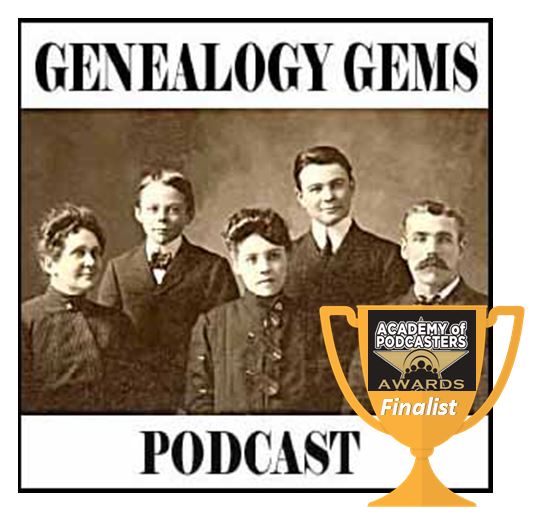 The FREE Genealogy Gems Podcast has been entertaining audiences on the “internet airwaves” for years! Nominated last year for the first-ever Academy of Podcasters awards, the show has had more than 1.75 million downloads worldwide. Host and producer Lisa Louise Cooke is loved for her warm conversational style, inspiring family history stories and the expert genealogy tips she threads into each episode–especially the tech tips we all need to keep up with the fast-paced and exciting world of genealogy.
The FREE Genealogy Gems Podcast has been entertaining audiences on the “internet airwaves” for years! Nominated last year for the first-ever Academy of Podcasters awards, the show has had more than 1.75 million downloads worldwide. Host and producer Lisa Louise Cooke is loved for her warm conversational style, inspiring family history stories and the expert genealogy tips she threads into each episode–especially the tech tips we all need to keep up with the fast-paced and exciting world of genealogy.
Thanks for listening! And thanks for recommending The Genealogy Gems Podcast to your genealogy buddies. You’re a Gem!
by Lisa Cooke | Jul 12, 2016 | 01 What's New, Genealogy Gems Podcast
 The Genealogy Gems Podcast
The Genealogy Gems Podcast
Episode # 193
by Lisa Louise Cooke
Episode highlights:
- Genealogy milestones, anniversaries, new records, upcoming conferences and new free video tutorials;
- Email response to The Genealogy Gems Podcast Episode #192: another tip on the U.S. Public Records Index, a family adoption story and his own research on the changing coastline of Sussex;
- More response to the “Where I’m From” poetry initiative;
- Announcement: the NEW Genealogy Gems Book Club title;
- A key principle in genetic genealogy from Your DNA Guide Diahan Southard.
NEWS: FOIA Turns 50
What is the FOIA? The Freedom of Information Act opens federal records to the public. The FOIA applies to certain kinds of information about the federal government and certain information created by the federal government. It DOESN’T apply to documents that relate to national security, privacy and trade secrets, or to documents created by state or local governments.
FOIA for genealogy research: Use the FOIA to request:
Click here to read an article on the 50th anniversary of the FOIA and more on FOIA for genealogy
NEWS: NEW RECORD COLLECTIONS ONLINE
Niagara Falls, Ontario, Canada, Honeymoon and Visitor Registers, 1949-2011
The Genealogy Gems Premium Podcast #133: Peggy Lauritzen on “Gretna Greens,” quickie wedding destinations (Premium eLearning membership required to access)
Announcement of Freedmen’s Bureau Project completion; In September 2016 you can access the full Freedmen’s Bureau Project at www.DiscoverFreedmen.org.
New videos to help find your family history in Freedmen’s Bureau Records
Where to find Freedmen’s Bureau Records online, and the Freedmen’s Bureau indexing project
NEWS: AncestryDNA Hits 2 Million Samples
Ancestry.com blog post: AncestryDNA Reaches 2 Million Samples
Your DNA Guide Diahan Southard talks about these AncestryDNA features in:
NEWS: UPCOMING CONFERENCES
3rd Annual Northwest Genealogy Conference
- Hosted by the Stillaguamish Valley Genealogical Society, north of Seattle in Arlington, WA on August 17-20, 2016
- Theme: “Family Secrets Uncovered — Lost History Found”
- Keynote speakers include Blaine Bettinger, Claudia Breland and Lisa Louise Cooke
- Free Day Wednesday afternoon: Beth Foulk will address beginner’s issues — which is also a good refresher for the more seasoned genealogists
- Other features: Meet a distant cousin with the “Cousin Wall;” participate in the genealogy-related scavenger hunt on Free Day Wednesday, and enjoy the free taco bar at the evening reception. Wear a costume from your ancestors’ homeland on the Friday dress-up day.
GEMS NEWS: NEW VIDEOS ONLINE
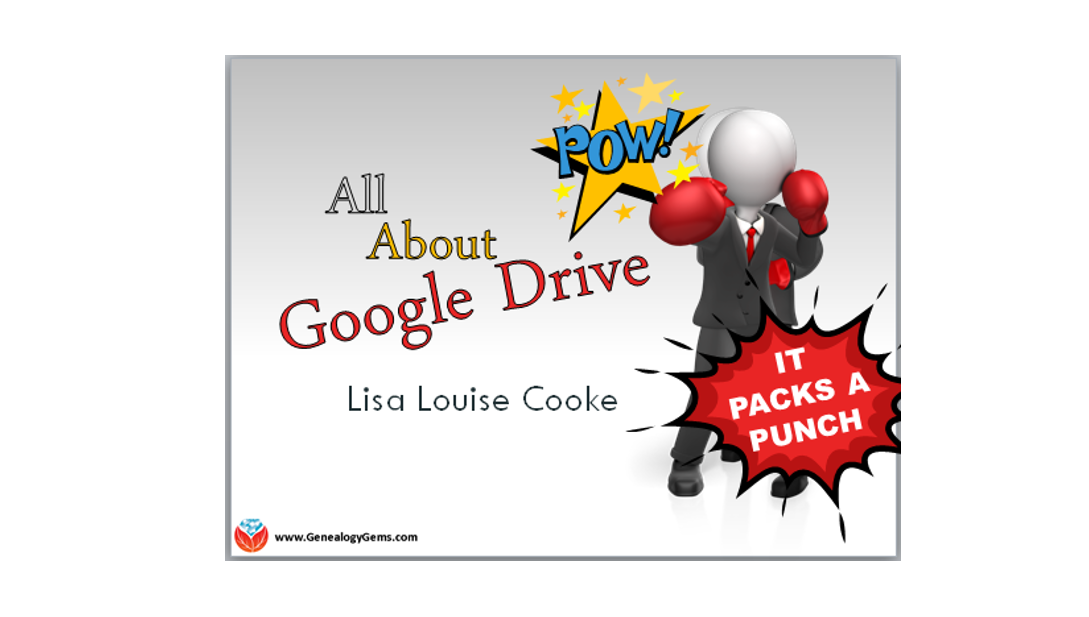
 MAILBOX: CHRIS WITH US PUBLIC RECORDS INDEX TIP AND MORE
MAILBOX: CHRIS WITH US PUBLIC RECORDS INDEX TIP AND MORE
Follow-up email regarding The Genealogy Gems Podcast episode #192 from Chris, who blogs at Leaf, Twig and Stem
Chris’ post about a compelling story of an adopted child in his family
Chris’ post about the changing coastline in Sussex
U.S. Public Records Index
MAILBOX: “WHERE I’M FROM”
The Genealogy Gems Podcast episode #185: Interview with George Ella Lyon
“Where I’m From” video and contest results
Tips for writing your own “Where I’m From” poem
Santa Clara County Historical and Genealogical Society “Where I’m From” contest: “Anyone near and far may join our Contest. Each entry receives a gift from the. We will have a drawing from all entries of cash or a nice prize. Deadline for entries is Aug. 31, 2016. More information on scchgs.org.”
NEW GENEALOGY GEMS BOOK CLUB SELECTION

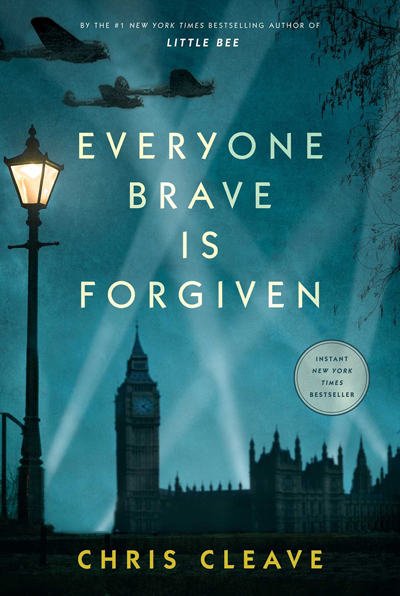 Everyone Brave is Forgiven by Chris Cleave
Everyone Brave is Forgiven by Chris Cleave
It’s a story inspired by love letters exchanged between his grandparents during World War II, when they were each in dangerous places: he on the island of Malta and she in London, both of which suffered some of the worst sustained bombing campaigns of the war.
Everyone Brave is Forgiven is a fast-paced book. It begins in London in 1939 with Mary North, a wealthy young lady from a privileged family who, on finding out that war has been declared, immediately leaves her finishing school and signs on for the war effort without telling her parents. She fulfills an assignment as a school teacher long enough to make a meaningful connection with a school official and one of her students. Then her students (along with the rest of London’s children) are evacuated to the countryside, leaving her to figure out what to do next.
The plot gets a lot more involved from here. There’s a love triangle, a long-distance romance, a series of scenes that take place on the heavily-bombarded island of Malta, harrowing descriptions of the London Blitz, homeless children who return from the evacuation only to find themselves parentless, homeless and in constant danger. It’s intense and eye-opening, but it’s compassionate and it’s still very readable for those who have less of a stomach for blood and guts but still want to understand some of the human experience of living and loving in a war zone, and then picking up the pieces afterward and figuring out how to keep living.
Video: Chris Cleave on the U.S troops coming to Europe in World War II
Click here for more Genealogy Gems Book Club titles
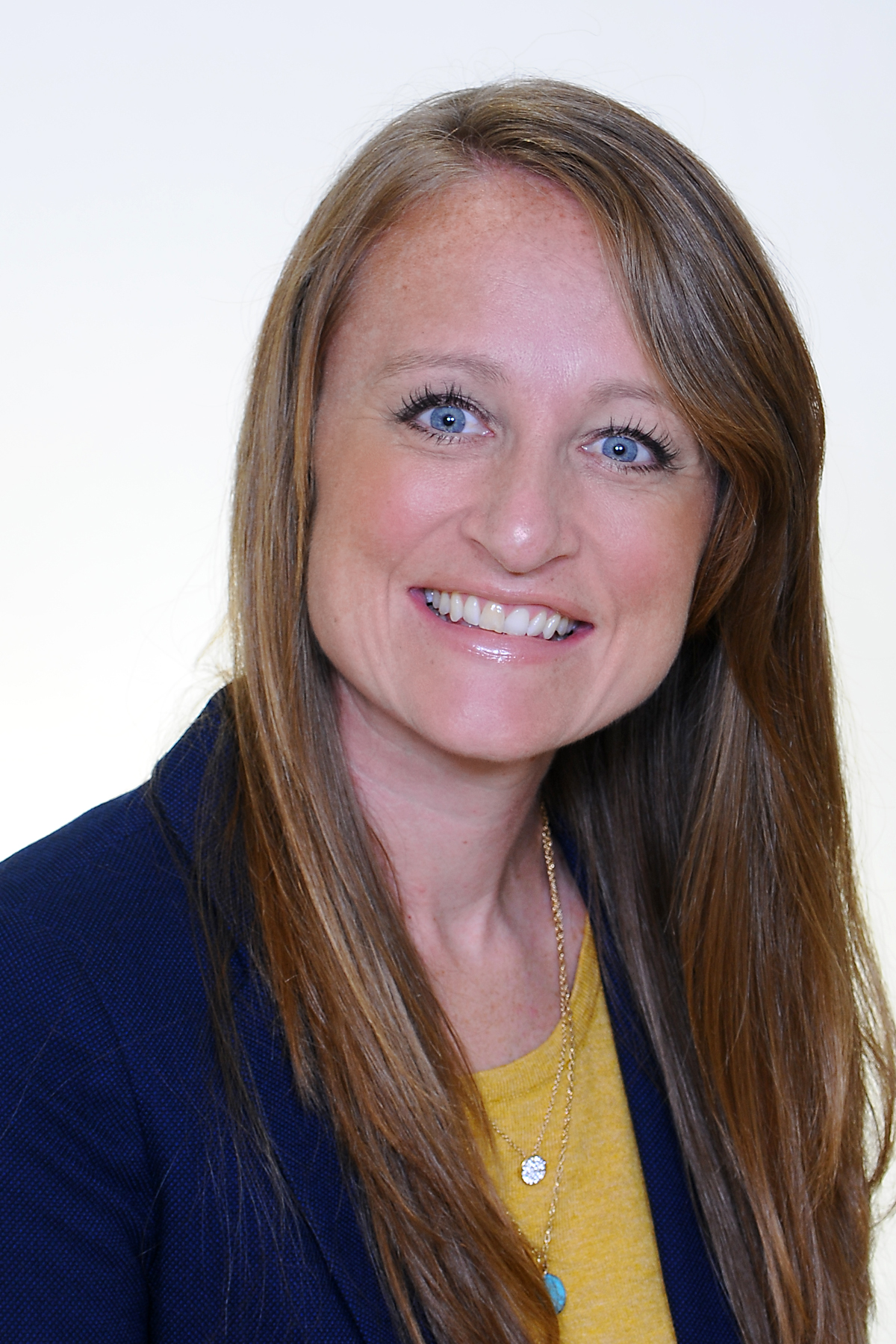 DNA GEM: GENETIC PEDIGREE V GENEALOGICAL PEDIGREE
DNA GEM: GENETIC PEDIGREE V GENEALOGICAL PEDIGREE
A key concept in genetic genealogy is that your genetic pedigree is different than your genealogical pedigree. Let me explain.
Your genealogical pedigree, if you are diligent or lucky (or both!) can contain hundreds, even thousands of names and can go back countless generations. You can include as many collateral lines as you want. You can add several sources to your findings, and these days you can even add media, including pictures and copies of the actual documents. Every time someone gets married or welcomes a new baby, you can add that to your chart. In short, there is no end to the amount of information that can make up your pedigree chart.
Not so for your genetic pedigree.
Your genetic pedigree contains only those ancestors for whom you have received some of their DNA. You do not have DNA from all of your ancestors. Using some fancy math we can calculate that the average generation in which you start to see that you have inherited zero blocks of DNA from an ancestor is about seven. But of course, most of us aren’t trying to figure out how much of our DNA we received from great great great grandma Sarah. Most of us just have a list of DNA matches and we are trying to figure out if we are all related to 3X great grandma Sarah. So how does that work?
Well, the first thing we need to recognize is that living descendants of Sarah’s would be our fourth cousins (though not always, but that is a topic for another post!). Again, bring in the fancy math and we can learn that living, documented fourth cousins who have this autosomal DNA test completed will only share DNA with each other 50% of the time.
Yes, only half.
Only half of the time your DNA will tell you what your paper trail might have already figured out: That you and cousin Jim are fourth cousins, related through sweet 3X great grandma Sarah. But here’s where the numbers are in our favor. You have, on average, 940 fourth cousins. So if you are only sharing DNA with 470 of them, that’s not quite so bad, is it? And it only takes one or two of them to be tested and show up on your match list. Their presence there, and their documentation back to sweet Sarah, helps to verify the genealogy you have completed and allows you to gather others who might share this connection so you can learn even more about Sarah and her family. Plus, if you find Jim, then Jim will have 470 4th cousins as well, some of which will not be on your list, giving you access to even more of the 940.
This genetic family tree not matching up exactly with your traditional family tree also manifests itself in your ethnicity results, though there are other reasons for discrepancies there as well.
In short, this DNA stuff is not perfect, or even complete, but if you combine it with your traditional resources, it can be a very powerful tool for verifying and extending your family history.
Additional readings:
PROFILE AMERICA: First hamburgers at a 4th of July picnic

Check out this episode!
Disclosure: This article contains affiliate links and Genealogy Gems will be compensated if you make a purchase after clicking on these links (at no additional cost to you). Thank you for supporting Genealogy Gems!
by Lisa Cooke | Jun 4, 2016 | 01 What's New, Adoption, Listeners & Readers
This story of DNA for adoption research tells how one Genealogy Gems listener discovered biological roots that were closer to her adopted home than expected.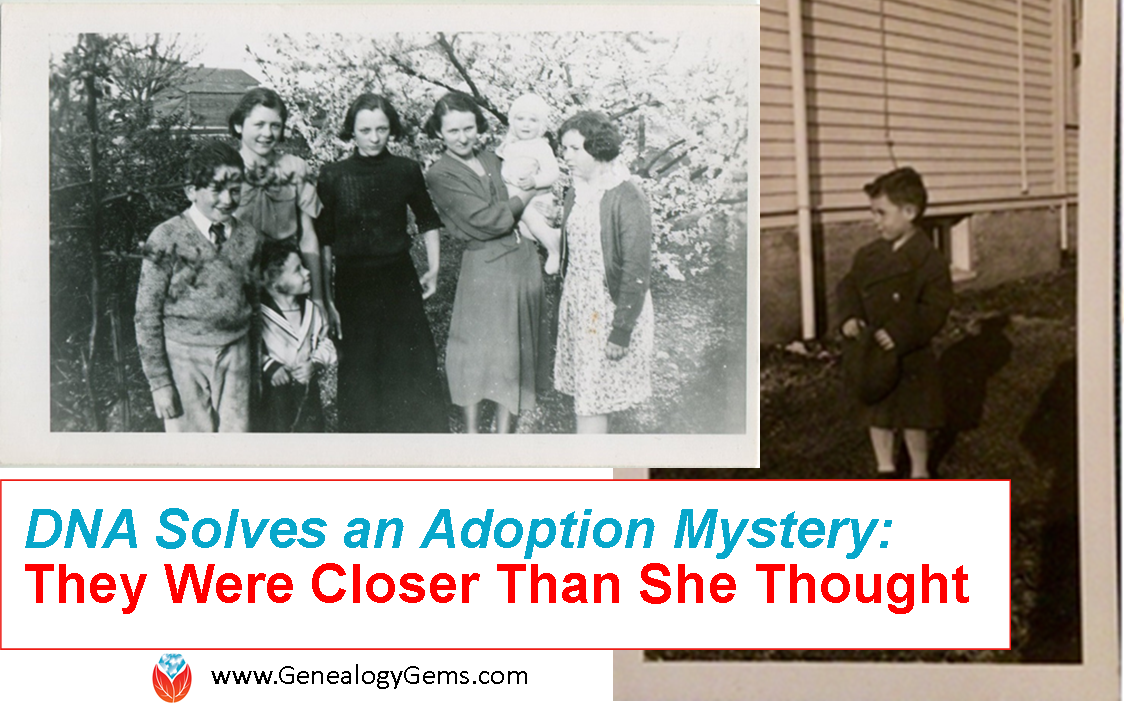
You never know what you’re going to learn when you start researching the biological roots of an adopted ancestor. And that was certainly the case for Katie from Pacifica, CA. Recently, she wrote me to share her story of researching an adopted ancestor. Understandably, people hope for a happy ending when using DNA for adoption research. But in Katie’s case, it may be just the beginning. Here’s why:
 “When I set out on this geni-journey, my goal was to find my grandfather’s birth parents. [He was adopted.] But as I read all the old family letters and newspaper clippings, I found myself getting so attached to his adoptive family. I was saddened that we weren’t blood-related, because I felt so connected and proud of them.
“When I set out on this geni-journey, my goal was to find my grandfather’s birth parents. [He was adopted.] But as I read all the old family letters and newspaper clippings, I found myself getting so attached to his adoptive family. I was saddened that we weren’t blood-related, because I felt so connected and proud of them.
My mother and I decided to take the AncestryDNA test, not sure what we’d find. When we got the results back, the strangest thing happened. My closest match with a family tree was a descendant of my grandfather’s adoptive grandfather.
My other closest match was adopted. He had been searching for his birth parents since the 1970s. When I called my adopted match, I think we were both excited and confused, not really sure how we’d be able to help each other in our search. As we compared notes, everything started clicking together. He began to cry. This mystery cousin of mine was no cousin at all. He was my grandfather’s half-brother. He was my great uncle, who was raised by a different, unrelated adoptive family!
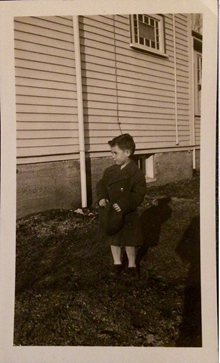
Katie’s grandfather at 4 years old, shortly after being adopted by Angela.
My grandfather, Joseph, turned out to be the biological nephew of his adoptive mother, Angela. His birth father was Angela’s brother, Paul. Angela’s own son tragically died of a ruptured appendix at age 4. Her husband, Ralph, was a merchant ship captain who traveled regularly all over the world, but most commonly between Oakland, CA and Brooklyn, NY.
According to family lore, less than a year after their son’s passing, Ralph mysteriously brought a freckly little boy (my grandpa) home to Oakland with him from Brooklyn, shocking his wife with this child she was suddenly expected to raise. Can you imagine that boat ride, all the way through the Panama Canal, as a confused orphan? And oh the family rumors that started!
Using DNA, we were able to put those rumors to rest. I’m not sure if Angela ever learned the truth– I’m not sure what Ralph told her, whether she even knew she was raising her own brother’s boy. All those years grandpa never asked who his birth parents were because he was afraid of hurting the family’s feelings, and little did he know he was being raised by his aunt the whole time. He probably met or at least wrote to his father without ever knowing it.
I have now met both my great half uncle, whose adoptive name is Bill (born Paul, in honor of his deceased birth father)– he lives in NY– and his son [Tom].
At 69 years old, that was his first time meeting a blood relative. I also connected with two living cousins in their 90s
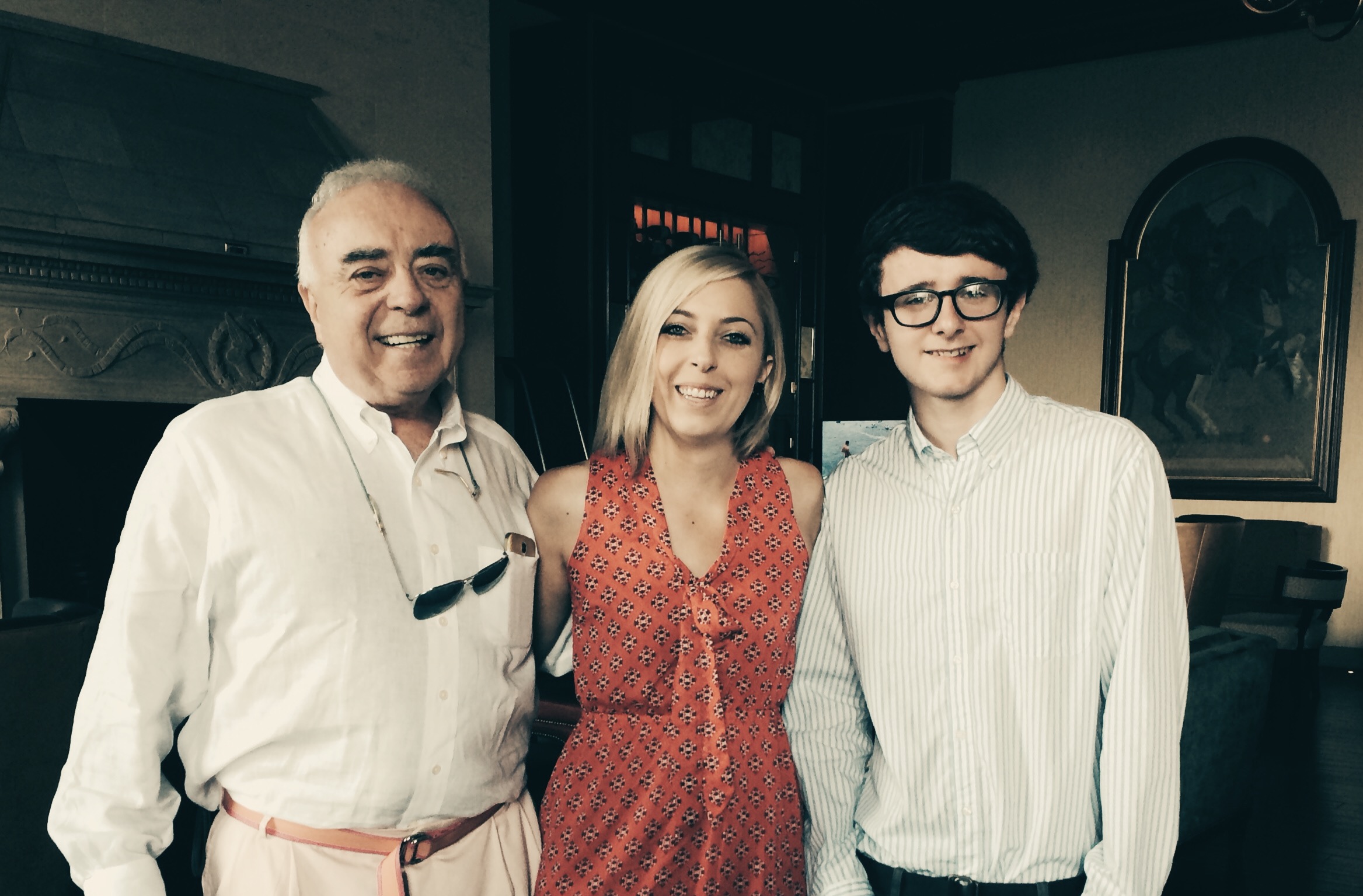
William Paul Nolan (left), born Paul Toomey, and his son, Tom (right), meeting Katie, their first known blood relative.
thanks to their very sweet children and nieces. I had photos of them from 1935, standing with my grandfather when he was only four years old, having no idea who they were until I started doing research.
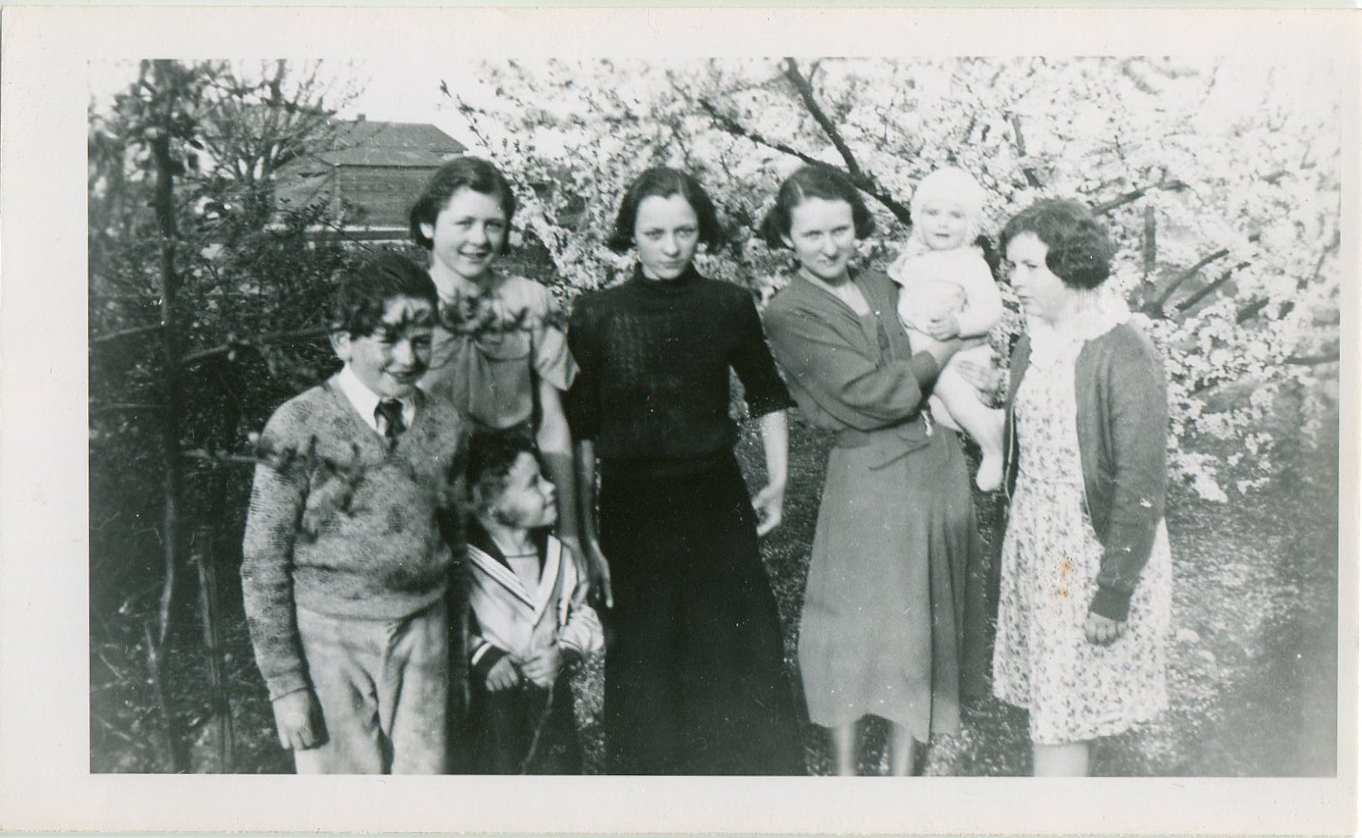
Katie’s grandfather as a little boy (in the sailor suit, second from left) with his adoptive first cousins (who were of blood relation), including Jack (10) and Loretta McKinnon (13). On the right is Katie’s grandfather’s adoptive sister (who would have been his first cousin by birth), Clare.
I couldn’t believe they were still around! I was able to meet them last year. I was also able to provide them with photos of their father, as they had only
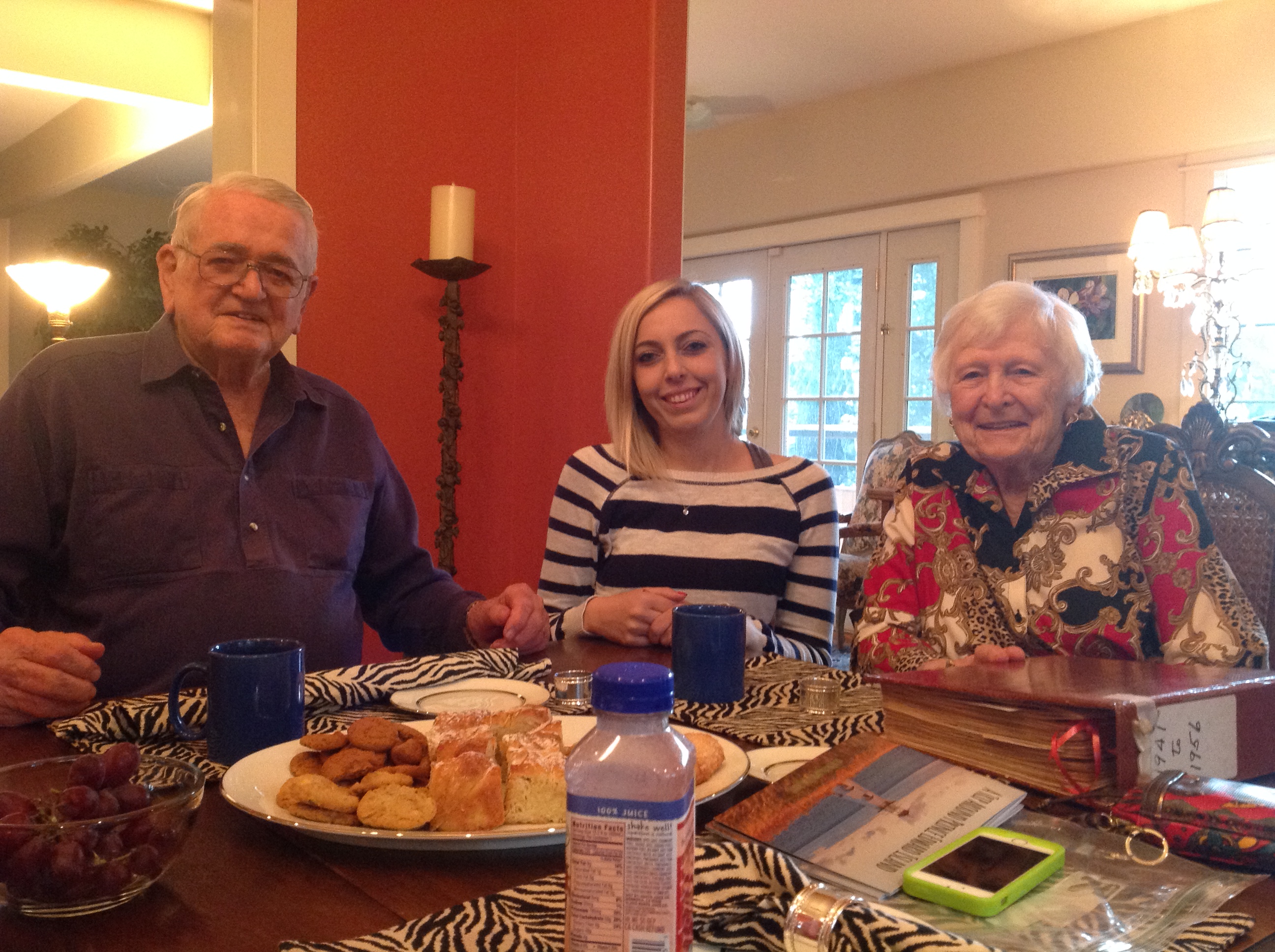
Jack (90, left) and Loretta (93, right) McKinnon meet Katie for the first time in 2015, 80 years after the photo with her grandfather was taken.
a few of their own.
I now send regular emails to the whole reunited family to update them on my genealogy discoveries.
I went on an homage journey to Prince Edward Island, the place my adoptive and birth great grandparents grew up, and was able to lay flowers at the gravestones of our long lost family members. The house they grew up in was still standing. Still being lived in, even!
It was such an amazing discovery after feeling so mysteriously close to that family, to know that it wasn’t all in my head. And to find out I had an uncle still living? Amazing.”
When Katie’s story landed in my inbox, it reminded me how lucky I am that so many of you share your personal, and inspiring stories! Thank you to Katie for giving us permission to share this inspiring story about using DNA for adoption research. You can read more about her family history adventures at her blog called McKinnon Ancestry.
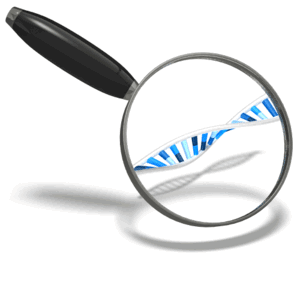 More DNA for Adoption Gems
More DNA for Adoption Gems
DNA for Adoption Research: Nice to Meet You!
Genealogy Gems Podcast episode 178: CeCe Moore Talks about Genealogy and Adoption (Listen for free)
DNA Testing for Adoptees: Advice from Your DNA Guide
by | May 25, 2016 | 01 What's New, Adoption, Beginner, DNA, Premium Video
 Ready to start DNA testing for family history? Or maybe you’ve tested but need help getting the most out of your results. Here’s a new video for you: Getting Started in Genetic Genealogy.
Ready to start DNA testing for family history? Or maybe you’ve tested but need help getting the most out of your results. Here’s a new video for you: Getting Started in Genetic Genealogy.
If you’re new to DNA testing for family history–or floundering along the way–the new Genealogy Gems Premium video tutorial may be just what you’re looking for. Millions of people have already tested, and savvy genealogists use those test results to better understand their ethnicity and family connections.
Your DNA Guide Diahan Southard, author of a fantastic series of laminated DNA guides, walks you through the answers to three important DNA questions in Getting Started in Genetic Genealogy:
1. Which test should I take?
2. What will I get from the testing?
3. Will it help?
In this video, Diahan reminds us that “genetic genealogy is not about miracles.” In fact, DNA testing for family history works best when paired with good old traditional research. You know, creating a pedigree chart, finding records, and searching dusty courthouse basements. (You didn’t think you were going to get out of that, did you?)
Diahan breaks down the elements of atDNA, mtDNA, and YDNA testing. You will want to hear why she gives a five star rating to YDNA, but only a three star rating to mtDNA! Click the video below to get a quick preview of this exciting class:
DNA testing supplements traditional genealogy research in many ways. For the majority of us, even the basic autosomal DNA test can provide us with a long list of cousin matches. The more family members you have tested, the more matches you will find. Cousin matches are fun, but they are also the tools we need to break down those brick walls. Maybe your DNA results will lead to finding Cousin Susie who just happened to get the family Bible. Wouldn’t you like to have the opportunity to get to know her?
 In my own family, our true ethnicity was carefully hidden. Traditional research hinted to our racial identity, but it wasn’t until a DNA test was taken that we were sure. Adoptees and foster children are also finding DNA tests helpful in locating their next of kin.
In my own family, our true ethnicity was carefully hidden. Traditional research hinted to our racial identity, but it wasn’t until a DNA test was taken that we were sure. Adoptees and foster children are also finding DNA tests helpful in locating their next of kin.
Genealogy Gems Premium website members have exclusive access to Getting Started in Genetic Genealogy and 30 additional full-length video tutorials on topics ranging from research strategies to technology tools. They also have access to the full audio archive of the Genealogy Gems Premium podcast. Click here to learn more about Premium website membership.
More Gems on DNA Testing for Family History
 3 Reasons to Test Your DNA for Genealogy
3 Reasons to Test Your DNA for Genealogy
Confused by Your Ancestry DNA Matches? Read This Post
YDNA for Genealogy: 3 Scenarios When YDNA is Useful
Page 7 of 13« First«...56789...»Last »



 According to their November 9th Q and A, MyHeritage hasn’t decided yet if the ethnicity features will be available to those who only transfer, and they hint at many more features they have in the works that may only be offered to those who purchase their test.
According to their November 9th Q and A, MyHeritage hasn’t decided yet if the ethnicity features will be available to those who only transfer, and they hint at many more features they have in the works that may only be offered to those who purchase their test. DNA testing is an incredible tool for genealogists. With several different types of tests and testing companies, hundreds of matches, and lots of technical jargon, it can be challenging to make sense of it all. My DNA Quick Guides to help you pick the right test, understand your results, and take the next steps with your matches. These guides can be purchased in printed format or digital downloads.
DNA testing is an incredible tool for genealogists. With several different types of tests and testing companies, hundreds of matches, and lots of technical jargon, it can be challenging to make sense of it all. My DNA Quick Guides to help you pick the right test, understand your results, and take the next steps with your matches. These guides can be purchased in printed format or digital downloads.

 The Genealogy Gems Podcast episode 193 is ready for listening! It’s packed with genealogy news you can use; inspiring tips from listeners and experts and the NEW Genealogy Gems Book Club pick.
The Genealogy Gems Podcast episode 193 is ready for listening! It’s packed with genealogy news you can use; inspiring tips from listeners and experts and the NEW Genealogy Gems Book Club pick. My favorite segment in
My favorite segment in 



 Everyone Brave is Forgiven
Everyone Brave is Forgiven DNA GEM: GENETIC PEDIGREE V GENEALOGICAL PEDIGREE
DNA GEM: GENETIC PEDIGREE V GENEALOGICAL PEDIGREE
 “When I set out on this geni-journey, my goal was to find my grandfather’s birth parents. [He was adopted.] But as I read all the old family letters and newspaper clippings, I found myself getting so attached to his adoptive family. I was saddened that we weren’t blood-related, because I felt so connected and proud of them.
“When I set out on this geni-journey, my goal was to find my grandfather’s birth parents. [He was adopted.] But as I read all the old family letters and newspaper clippings, I found myself getting so attached to his adoptive family. I was saddened that we weren’t blood-related, because I felt so connected and proud of them.










